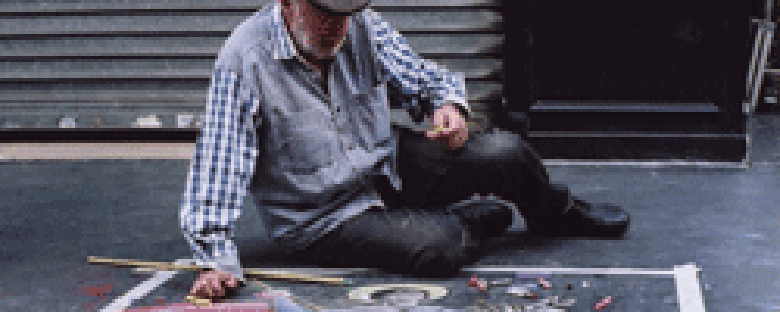Reviews
Jardins en automne
Otar Iosseliani
France, 2006
Credits
Review by Jenny Jediny
Posted on 28 September 2006
Source Les Films du Losange 35MM Theatrical Print
Related articles
Features: The 44th New York Film Festival
The rediscovery of the simple life by the middle aged is a common topic in cinema and literature, a renewed appreciation for a past that may have been forgotten in the pursuit of money or power. In Gardens in Autumn, director Iosseliani’s depiction of this status transition is styled in the likeness of famed French director Jacques Tati. The film lacks a great deal of dialogue, instead relying on physical humor to convey the absurdity of situations or characters, and while filmed in the city of Paris, avoids clichéd and recognizable locations, instead taking place in smaller, more intimate neighborhoods. Although the humor is mildly amusing, the work has neither the wit nor the incredible playfulness so deftly pulled off by Tati, instead melding into an odd blend of antics that do not so much criticize this bourgeois version of an unencumbered lifestyle as find it endearing.
Iosseliani’s film concerns a governmental Minister who is fired from his cushy position. As a result, his mistress leaves him for one of his higher-ups, and his home and possessions are revoked, leaving him without purpose or income. The Minister retreats to his old neighborhood in Paris, where he reunites with not only his family but also old friends, a curious blend of half-hearted clergymen, gardeners and ex-girlfriends, quickly discovering that the simple life is very much desirable indeed.
The stated poverty of the unemployed Minister is portrayed as an opportunity for folly on his behalf, but any uncomfortable or embarrassing situations (asking his Mother for money, being verbally slandered by the “proletariat,” having foul bath water dumped on him by an angry squatter) are undercut by the relative ease the Minister finds in constructing his new lifestyle. His mother appears to live in a chateau and dolls out funds for him without question while advising him to take up in his old flat, a large, relatively jaw-dropping townhouse, that while taken over by squatters, will eventually make its way back into the Minster’s possession. Even the desertion of his mistress makes the Minster much happier, as he finds solace and physical satisfaction with not one, but three different women, all of whom appear to adore him. In a rather Felliniesque homage (and a sexist one at that), a scene toward the end of the film gathers all of the women in the Minister’s life together at an outdoor dinner, conversing and chatting, whether family, ex-wife, or current lovers.
At best, Gardens in Autumn conveys an acute sense of the instability of material and luxury, passing clothes, knickknacks, and homes between individuals as if throwing a ball back and forth. The ineffectualness of the film stems from the unconvincingly good luck, rather than ill fortune, that seems to beset the Minister upon his removal from office. Obviously the French imitate the phrase joie de vivre with a passion, and it is evident that this life is far more enjoyable than the one the Minister left behind in office. However the depiction of this supposedly simple life of planting trees while nursing expensive wine becomes rather uninspired, and at times uncomfortable; in particular, scenes involving the squatters at his reclaimed home leave a rather unpleasant and contradictory sentiment. A common problem in France, the squatters, illegal immigrants from Africa, have managed to move in nearly thirty plus people into the home, as housing cannot be found elsewhere for these families and individuals (a common belief is that racism is a key element and prohibitive factor for these workers in finding legal housing). After the Minister calls in a favor to his old office, they are removed by the police, and later reappear after the Minister, too drunk to go home, spends the night with the group under a bridge by the Seine. The scene attempts to pull off humor with this encounter, conveying some kind of encompassing harmony as they are all human, after all, and will all end up in the same place (i.e., la morte). The lack of understanding — or even of acknowledging the implications of depicting a genuine political problem as simplistic humor — is not ironic, but crude and certainly insensitive.
In the end, Iosseliani seems most concerned with impending death, as middle-aged men enter the autumn of their lives with the knowledge that eventually it will all be a faded memory and they will cease to exist. The film’s opening, a brief stop at a coffin shop, puts the film’s intention and self-absorption on the table straight away, although it would indicate that even in death, men must not only possess, but control their last material object. Unfortunately, Iosseliani’s film, although at times visually interesting, lacks the depth and wisdom that one would hope accompanies this stage in life. Poet Laureate Donald Hall elegantly states in “Affirmation,” “Let us stifle under mud at the pond’s edge and affirm that it is fitting and delicious to lose everything,” a fitting and far more moving reaction to not only old age, but that unstoppable clock.
We don’t do comments anymore, but you may contact us here or find us on Twitter or Facebook.



